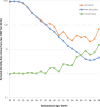Placental abruption and perinatal mortality in twins: novel insight into management at preterm versus term gestations
- PMID: 39576360
- PMCID: PMC11646271
- DOI: 10.1007/s10654-024-01171-z
Placental abruption and perinatal mortality in twins: novel insight into management at preterm versus term gestations
Abstract
Twins suffer a disproportionately higher burden of adverse perinatal outcomes than singletons. However, the degree to which preterm delivery shapes the relationship between abruption and perinatal mortality in twins is unknown. Through causal mediation decomposition, we examine how preterm delivery mediates the effect of abruption on perinatal mortality among twins using the US-matched multiple birth data (1995-2000). We estimated the hazard ratio (HR) from Cox models with gestational age as the timescale. We decomposed the total effect (TE) into counterfactual natural direct (NDE) and natural indirect (NIE) effects. 557,220 matched twin births, 1.3% (n = 7032) resulted in abruption with higher perinatal mortality rates than non-abruption births (143 versus 36 per 1000 births, respectively) and a 4.53-fold (95% confidence interval [CI]: 4.23, 4.82) increased hazard of perinatal mortality. HRs for NDE and NIE were 3.05 (95% CI: 2.84, 3.24) and 1.49 (95% CI: 1.49, 1.47, 1.50), respectively, and the proportion mediated (PM) was 41%. PM increased as the gestational age at delivery decreased. Associations persisted after correction for unmeasured confounders. The best strategies to improve perinatal delivery are delivery when abruption complicates twin pregnancies at term gestations and expectant management (avoiding early preterm delivery), if feasible, when abruption complicates twin pregnancies at preterm gestations.
Keywords: Causal mediation analysis; Perinatal mortality; Placental abruption; Preterm delivery.
© 2024. The Author(s).
Conflict of interest statement
Declarations. Ethical approval: No ethics approval was required since the data used in this study was available in de-identified form. Competing interests: None declared.
Figures




Similar articles
-
Birth weight discordancy and adverse perinatal outcomes among twin gestations in the United States: the effect of placental abruption.Am J Obstet Gynecol. 2003 Apr;188(4):954-60. doi: 10.1067/mob.2003.210. Am J Obstet Gynecol. 2003. PMID: 12712093
-
Placental abruption and perinatal mortality with preterm delivery as a mediator: disentangling direct and indirect effects.Am J Epidemiol. 2011 Jul 1;174(1):99-108. doi: 10.1093/aje/kwr045. Epub 2011 Mar 23. Am J Epidemiol. 2011. PMID: 21430195 Free PMC article.
-
Comparing pregnancy outcomes and loss rates in elective twin pregnancy reduction with ongoing twin gestations in a large contemporary cohort.Am J Obstet Gynecol. 2019 Sep;221(3):253.e1-253.e8. doi: 10.1016/j.ajog.2019.04.001. Epub 2019 Apr 14. Am J Obstet Gynecol. 2019. PMID: 30995460
-
Epidemiology of twinning in developed countries.Semin Perinatol. 2012 Jun;36(3):156-61. doi: 10.1053/j.semperi.2012.02.001. Semin Perinatol. 2012. PMID: 22713495 Review.
-
Prevention of preterm birth in twin pregnancies.Am J Obstet Gynecol MFM. 2022 Mar;4(2S):100551. doi: 10.1016/j.ajogmf.2021.100551. Epub 2021 Dec 8. Am J Obstet Gynecol MFM. 2022. PMID: 34896357 Review.
References
-
- Ananth CV, et al. Placental abruption and adverse perinatal outcomes. JAMA. 1999;282(17):1646–51. - PubMed
-
- Ananth CV, Wilcox AJ. Placental abruption and perinatal mortality in the United States. Am J Epidemiol. 2001;153(4):332–7. - PubMed
-
- Ananth CV, et al. Placental abruption among singleton and twin births in the United States: risk factor profiles. Am J Epidemiol. 2001;153(8):771–8. - PubMed
-
- Martin JA, Hamilton BE, Osterman MJ. Three decades of twin births in the United States, 1980–2009. NCHS Data Brief. 2012(80):1–8. - PubMed
MeSH terms
Grants and funding
LinkOut - more resources
Full Text Sources
Medical

